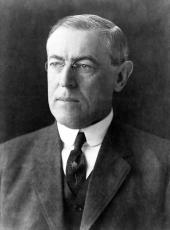
Proclamation 1290—Opening Lands in the Standing Rock Indian Reservation, North and South Dakota
By the President of the United States of America
A Proclamation
I, Woodrow Wilson, President of the United States of America, by virtue of the power and authority vested in me by the Act of Congress approved February 14, 1913 (37 Stat., 675), do hereby prescribe, proclaim and make known that all the non-mineral, unallotted and unreserved lands within the Standing Rock Indian Reservation, in the States of North and South Dakota, shall be disposed of under the general provisions of the homestead laws of the United States and the said Act of Congress, shall be opened to settlement and entry, and shall be settled upon, occupied and entered in the following manner, and not otherwise:
1. Execution and Presentation of Applications.
Any person who is qualified to make entry under the general provisions of the homestead laws may swear to and present an application to make homestead entry of these lands on or after May 3, 1915, or any such person who is entitled to the benefits of Sections 2304, 2305 and 2307, of the Revised Statutes of the United States, may file a declaratory statement for these lands on or after said date. Each application to make homestead entry and each declaratory statement filed in person must be sworn to by the applicant before the Register or the Receiver of the United States land office for the district in which the lands are situated, or before a United States Commissioner, or a judge or a clerk of a court of record residing in the county in which the land is situated, or before any such officer who resides outside the county and in the land district and is nearest or most accessible to the land. The agent's affidavit to each declaratory statement filed by agent must be sworn to by the agent before one of such officers on or after May 3, 1915, but the power of attorney appointing the agent may be sworn to by the declarant on or after April 1, 1915, before any officer in the United States having a seal and authority to administer oaths. After applications have been so sworn to, they must be presented to the Register and Receiver of the proper land office. Applicants may present the applications in person, by mail, or otherwise. No person shall be permitted to present more than one application in his own behalf.
2. Purchase money, Fees and Commissions.
One-fifth of the purchase price of the land applied for must be paid at the time of entry and a sum equal thereto must be tendered with all applications to make homestead entry. Such sum will also be required with declaratory statements presented on or before May 17, 1915, and when so tendered will be disposed of as hereinafter provided. In addition, each application to make homestead entry must be accompanied by a fee of $5, if the area is 80 acres or less, or $10, if more than 80 acres, and commissions at the rate of $.02 1/2 for each acre applied for; and for each declaratory statement must be accompanied by a fee of $2.
3. Disposition of Applications.
All homestead applications and declaratory statements received by the proper Register and Receiver on or after May 3, 1915, and on or before May 17, 1915, will be treated as filed simultaneously, and where there is no conflict such applications and statements, if in proper form and accompanied by the required payment, will be allowed on May 19, 1915. If such applications or statements conflict in whole or in part, the right of the respective applicants will be determined by public drawings, to be conducted by or under the supervision of the Superintendent of Openings and Sales of Indian Reservations. A drawing will be conducted for lands in North Dakota at the United States land office for the district in which the lands are situated, beginning at 10 o'clock, a.m., on May 19, 1915, and for lands in South Dakota at the United States land office for the district in which the lands are situated, beginning at 10 o'clock, a.m., on May 21, 1915. The names of the persons who presented the conflicting applications and statements will be written on cards and these cards shall be placed in envelopes upon which there are no distinctive or identifying marks. These envelopes shall be thoroughly and impartially mixed, and, after being mixed, shall be drawn one at a time by some disinterested person. As the envelopes are drawn the cards shall be removed, numbered beginning with number one, and fastened to the applications of the proper persons, which shall be the order in which the applications and statements shall be acted upon and disposed of. If homestead application or declaratory statement cannot be allowed for any part of the land applied for, it shall be rejected. If it may be allowed for part of, but not for all, the land applied for, the applicant, or the declarant through his agent, shall be allowed thirty days from receipt of notice within which to notify the Register and Receiver what disposition to make thereof. During such time, he may request that the application or statement be allowed for the land not in conflict and rejected as to the land in conflict, or that it be rejected as to all the land applied for; or he may apply to have the application or statement amended to include other land which is subject to entry and to inclusion in his application or statement, provided he is the prior applicant. If it is determined by the drawing that a declaratory statement shall be acted upon and disposed of before a homestead application for the same land, the homestead applicant shall be allowed thirty days from receipt of notice within which to advise the Register and Receiver whether to allow or to reject the application. If an applicant or a declarant or his agent, fails to notify the Register and Receiver within the time allowed what disposition to make of the application or statement, it will be rejected as to all the land applied for. Homestead applications and declaratory statements which are presented after May 17, 1915, will be received and noted in the order of their filing, and will be acted upon and disposed of in the usual manner after all such applications and statements presented on or before that date have been acted upon and disposed of.
4. Disposition of Moneys. - - Moneys tendered with applications and statements presented on or before May 17, 1915, except fees for filing declaratory statements, will be deposited by the Receiver of the proper land office to his official credit and properly accounted for. The fee for filing a declaratory statement must be paid even though the application is rejected, and such fee will be properly applied when the statement is filed. When a homestead application is allowed in whole or in part, the sums required as fees, commissions and purchase money will be properly applied, and any sum in excess of the required amount will be returned to the applicant. When a declaratory statement is allowed in whole or in part, the sum which will be required as purchase money if entry is made under the declaratory statement will be held until entry has been allowed under the statement or the time has expired within which entry may be made and any sum in excess of the required amount will be returned to the declarant. The moneys held will not be returned until the time has expired within which entry may be made under the statement but will be returned as soon as possible thereafter if entry is not made. Moneys tendered with applications and statements which are rejected in whole, except fees for filing declaratory statements, will be returned. If an applicant or declarant fails to secure all the land applied for and amends his application or statement to embrace other lands, the moneys theretofore tendered will be applied on account of the required payment under the amended application. If it is not sufficient, the applicant or declarant will be required to pay the deficiency, and if it is more than sufficient, the excess will be returned. Moneys returned to applicants or declarants will be returned by the official check of the Receiver of the proper United States land office. Moneys tendered with applications or statements presented after May 17, 1915, will be deposited by the Receiver of the proper land office in the usual manner.
5. Price of Lands. - - Lands entered or filed upon prior to August 19, 1915, must be paid for at the rate of $5 per acre; those entered or filed upon on or after that date and prior to November 19, 1915, at the rate of $3.50 per acre; and those entered or filed upon on or after November 19, 1915, at the rate of $2.50 per acre. Should land be re-entered or re-filed upon, the price will be that fixed by the first entry or filing.
6. Residence and Cultivation. - - The residence, cultivation and improvements which will be required in connection with entries of these lands will be the same as are required in connection with other lands entered under the general provisions of the homestead laws.
7. Deferred payments. - - The portion of the purchase price of the land which is not required when entry is made, may be paid in five equal installments, the first within two years from the date of entry and the remainder annually in three, four, five and six years, respectively, thereafter, unless commutation proof is submitted. If commutation proof is submitted, final payment must be made at that time. If three-year proof is submitted, final payment may be made then or at any time thereafter before the payments become due in the annual installments. Neither final certificate nor patent will issue under a three-year proof until final payment of purchase money has been made.
8. Forfeitures. - - If an entryman fails to make any payment when it becomes due, or fails to comply with the requirements as to residence, cultivation or improvement, his entry will by canceled and all payments theretofore made by him under the entry will be forfeited.
9. Settlement in Advance of Entry. - - Claims may be initiated to these lands by settlement in advance of entry on and after November 19, 1915, and not before then.
10. Rules and Regulations. - - The Secretary of the Interior is hereby authorized to make and prescribe such forms, rules and regulations as may be necessary to carry the provisions of this Proclamation into full force and effect.
In Witness Whereof, I have hereunto set my hand and caused the seal of the United States to be affixed.
Done at the City of Washington this 18th day of March in the year of our Lord nineteen hundred and fifteen and of the independence of the United States the one hundred and thirty-ninth.

WOODROW WILSON
By the President:
W. J. BRYAN
Secretary of State.
Woodrow Wilson, Proclamation 1290—Opening Lands in the Standing Rock Indian Reservation, North and South Dakota Online by Gerhard Peters and John T. Woolley, The American Presidency Project https://www.presidency.ucsb.edu/node/277543
